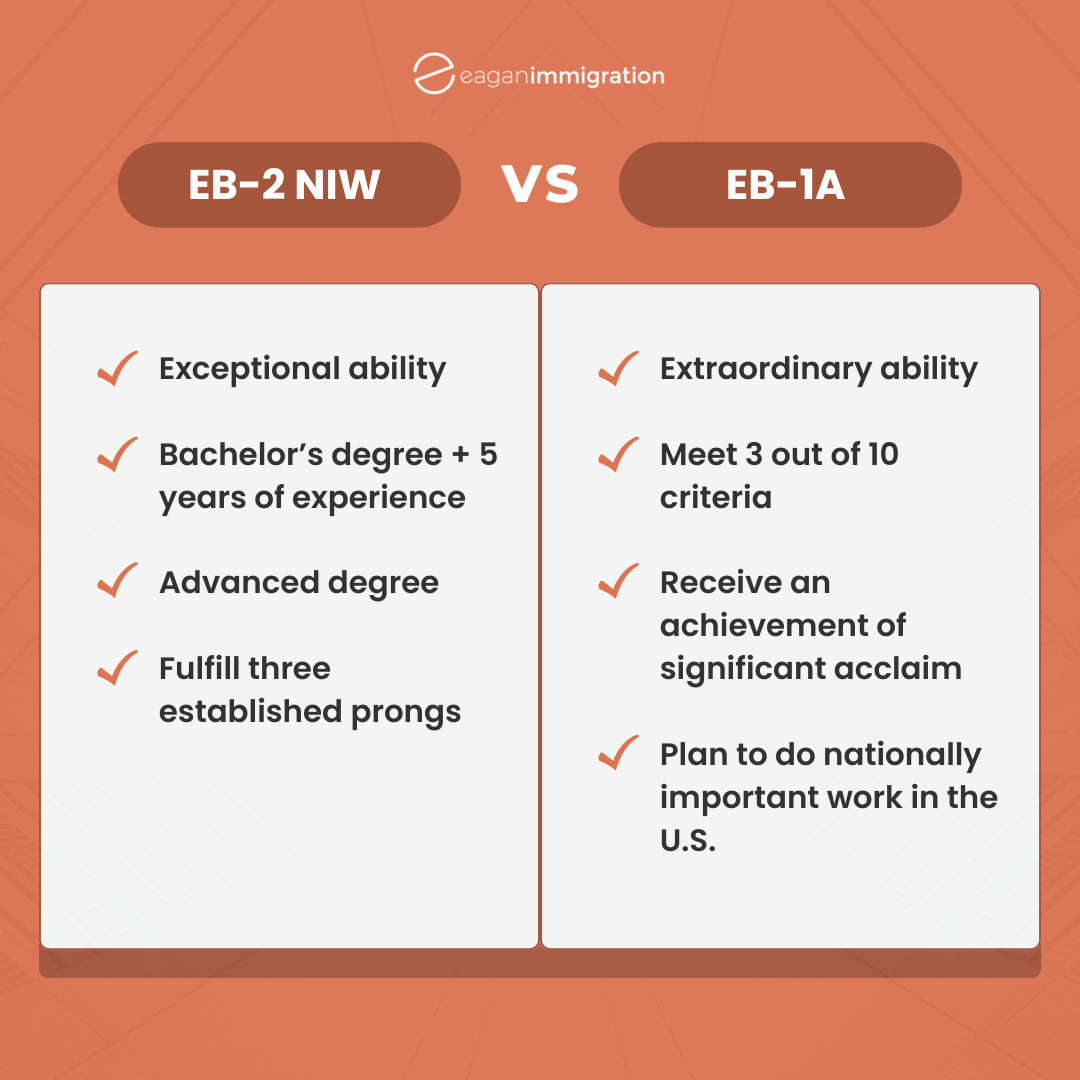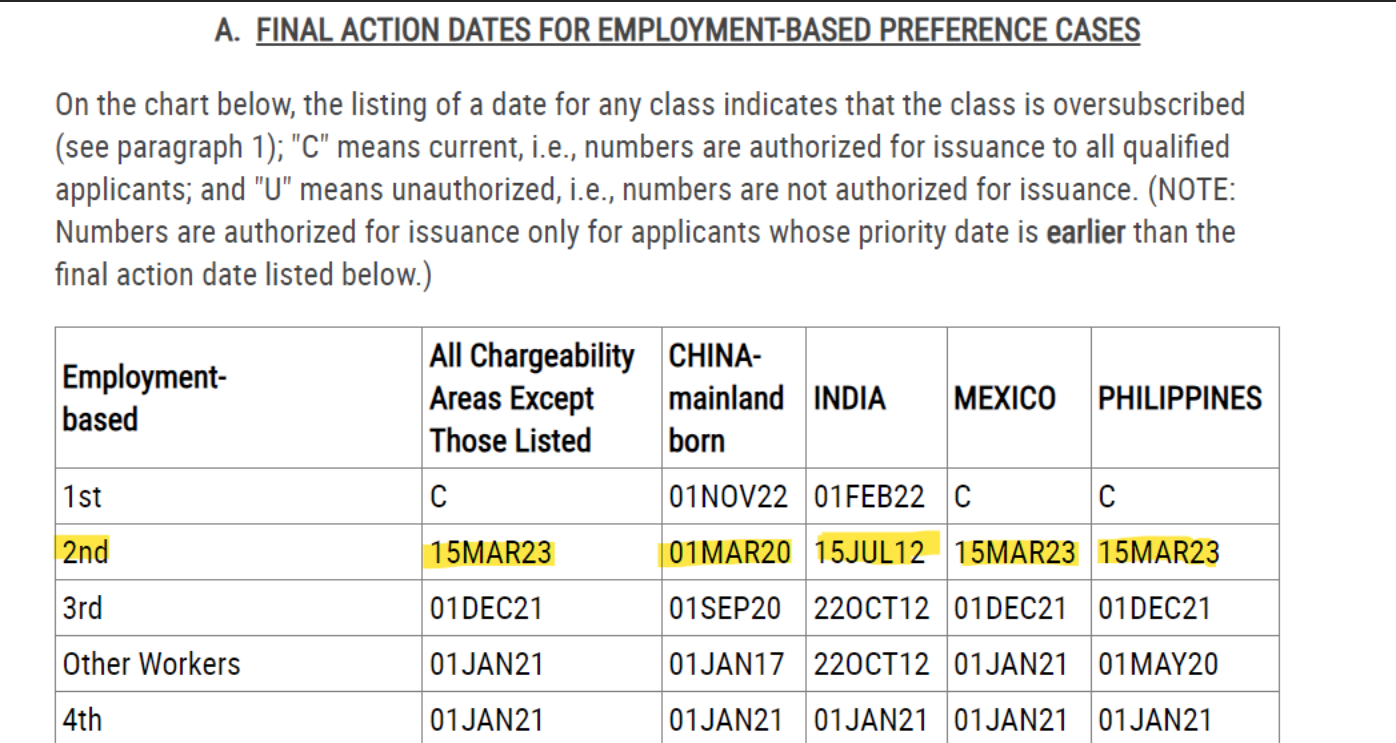5 Mistakes You’re Making When Filing the EB-2 NIW
- Business Immigration
- News
By Natalie McQuilkin
The EB-2 National Interest Waiver (NIW) is a great option for highly skilled or highly educated foreign nationals looking to self-petition so they can permanently live and work in the United States. It’s designed for those with exceptional ability in the arts, sciences, or business; a master’s degree or higher; or a bachelor’s degree plus five years of post-graduate experience. In this post, we’ll discuss five common mistakes foreign nationals make when self-petitioning for the EB-2 NIW so you can avoid doing the same when you file your petition.
Mistake #1: Confusing the EB-2 NIW with the EB-1A Green Card Pathway
The EB-2 NIW is repeatedly confused with the EB-1A, an employment-based, first-preference green card pathway that hinges on extraordinary ability in the arts, sciences, business, education, or athletics. It’s easy to see how the EB-2 NIW’s “exceptional ability” eligibility requirement can get confused with the EB-1A’s “extraordinary ability” requirement, but there are key differences between the two.
The main difference between the EB-2 NIW and the EB-1A is that the latter is designed for those who are off-the-charts talented. You can fulfill the EB-1A’s extraordinary ability criteria by meeting three out of ten criteria, which can be found here, or you can provide evidence that you’ve received a significant achievement of national or international acclaim, like the Pulitzer Prize or an Oscar. Meanwhile, the EB-2 NIW caters to those with at least a master’s degree or those with a bachelor’s degree plus five years of post-graduate experience. It also accommodates those with exceptional ability in their field, which USCIS defines as “a degree of expertise significantly above that ordinarily encountered in the sciences, arts, or business.” One example of this is a therapist who has received recognition and awards for their studies and work in their field.

Mistake #2: Thinking You Need a Sponsor for the EB-2 NIW
If you’ve done research on other employment-based green card pathways, you’re probably familiar with the fact that many pathways require employer sponsorships. However, the EB-2 NIW does not require this – instead, you petition yourself.
Essentially, the EB-2 NIW is a self-petition option for the EB-2 green card pathway. On its own, the EB-2 pathway accommodates those with an advanced degree, those with a bachelor’s degree plus five years of post-graduate experience, or those with exceptional ability, but it also requires an employer sponsorship. This adds several additional steps to the application process, as your employer will ultimately have to obtain a labor certification – a costly and lengthy process.
So, how does the EB-2 NIW allow you to self-petition? The National Interest Waiver component of the EB-2 NIW completely eliminates the labor certification requirement. It instead requires you to prove your work is in the interest of the United States, which then waives the labor certification and sponsorship requirements. Although proving this requires more work on your end, as you will have to collect supporting evidence and draft a cover letter and brief detailing your credentials, experience, and plans to work in the United States, the major upside is that you will not have to seek out an employer willing to hire you and undergo the labor certification process to petition you.
Mistake #3: Providing Insufficient Evidence
Although the EB-2 NIW green card pathway provides the flexibility of filing the petition yourself, it also has a long list of eligibility requirements. The EB-2 NIW heavily hinges on you establishing a proposed endeavor, or specific plans for your career or research in the United States. This must fulfill the EB-2 NIW’s three prongs, which include the following:
- The proposed endeavor has both substantial merit and national importance.
- You are well positioned to advance the proposed endeavor.
- On balance, it would be beneficial to the United States to waive the requirements of a job offer, and thus the labor certification, meaning you don’t need to rely on an employer to file a petition on your behalf.
So not only do you have to establish a proposed endeavor, but you also have to show how you plan to carry out the endeavor and how it will benefit the United States.
Here’s an example of a proposed endeavor that the Administrative Appeals Office (AAO) accepted: A UK-based consultant planned to work for several nonprofits and governmental groups to enhance U.S. veterans’ healthcare and services. The consultant had several years of experience doing the same job in the UK. The AAO found this proposed endeavor fulfilled the substantial merit and national importance prongs.
On the other hand, the AAO rejected an applicant who wanted to work as an attorney providing pro bono and low-rate services to impoverished communities. Although the AAO agreed this endeavor had substantial merit, they ultimately rejected it because the applicant failed to show how their work would benefit the United States as a whole. Instead, the applicant only portrayed how their services would benefit their clients. Perhaps if the client had explained how their work could assist in revolutionizing the country’s veteran services, the AAO might have approved their proposed endeavor.
With that being said, it’s important that you not only have a solid proposed endeavor, but you provide ample information about how you will carry out your plan. Then, you should portray how your endeavor will positively impact the United States. This is executed best when it includes plentiful details and research.
A common misconception about fulfilling the national importance prong is that pointing to a high growth rate in a specific occupation is enough to fulfill this requirement. However, these statistics usually aren’t enough to meet the threshold, so it’s important you consider additional evidence to include to strengthen the argument for national importance.
Mistake #4: Forgetting to Pay the Asylum Program Fee
In January 2024, USCIS published a final rule that adjusted many application fees, eliminating some fees completely. Because of this, USCIS has lost some revenue. USCIS expects to continue supporting certain programs, like the asylum program, by implementing the Asylum Program Fee for certain applications. This fee was first implemented April 1, 2024. Because this fee is relatively new, it’s easy to forget to submit it. However, it’s imperative that you pay it because if you fail to submit the correct fees, your form will be rejected.
Although the Asylum Program Fee is generally $600, you only have to pay $300 when filing an EB-2 NIW because the Asylum Program fee is reduced for small business and self-petitioners. To ensure you only have to pay $300, when filling out the Form I-140 (Immigrant Petition for Alien Workers), you will check “yes” on Part 1, Question 6 of the form. This question that asks if you employ 25 or fewer full-time employees. If you’re paying all the fees by check, you should pay the $715 for the Form I-140 and the $300 for the Asylum Program Fee using separate checks.
Mistake #5: Not Taking the Visa Bulletin Into Consideration
If you’re from India or China and are interested in the EB-2 NIW, it’s imperative that you realize there will be longer wait times for your EB-2 NIW to be processed. As of August 2024, USCIS is currently processing most second-preference employment-based visas from March 2023, but for those from mainland China and India, USCIS is processing applications from March 2020 and July 2012, respectively, primarily because there is a large backlog of applications from these countries. So, if you’re from mainland China and you file your EB-2 NIW now, it will be at least four years before your application is processed. If you’re from India, it could be more than 12 years.
However, this shouldn’t dissuade you from filing the EB-2 NIW. Yes, it will take longer for your application to be approved, but if you’re currently living in the U.S. on a visa, there are ways to extend your visa – especially if you have an H-1B visa – while you wait for your EB-2 NIW approval. If you’re unable to file your Form I-485 (Adjustment of Status), it’s possible to also change your status to O1 or E2 while you wait for your EB-2 NIW to be approved.

Next Steps
As we’ve learned in today’s post, there are many mistakes that can be made when filing the EB-2 NIW. This can definitely add pressure on you, especially if you are filing the EB-2 NIW by yourself. Hiring an immigration attorney can reduce the risk of these mistakes being made and minimize the chance that your application will be rejected. Here at Eagan, senior business immigration attorney, Hannah Whaley, is experienced in the world of EB-2 NIWs. Attorney Whaley will assess your case to determine if you meet the eligibility requirements and make unique, creative arguments to fulfill the “three prong” requirement. She will also fill out the required forms to ensure that they are completed as USCIS requires. Finally, she will keep you up to speed on how your case is progressing and will be available to answer your questions about priority dates. Having a trusted business immigration attorney by your side will not only minimize your worries during the filing process.
Start your case evaluation today by calling us at 202-709-6439 or visiting this link.
References:
Employment-Based Immigration: First Preference EB-1, USCIS, (Mar. 1, 2022), Employment-Based Immigration: First Preference EB-1 | USCIS.
Employment-Based Immigration: Second Preference EB-2, USCIS, (Apr. 20, 2022), Employment-Based Immigration: Second Preference EB-2 | USCIS.
Successful Proposed Endeavors for EB-2 NIW Green Card Applications, Shaffer Immigration Law, (Jan. 17, 2023), Successful Proposed Endeavors for EB-2 NIW Green Card Applications (shafferimmigrationlaw.com).
U.S. Citizenship and Immigration Services Fee Schedule and Changes to Certain Other Immigration Benefit Request Requirements, Federal Register, (Jan. 31, 2024), Federal Register :: U.S. Citizenship and Immigration Services Fee Schedule and Changes to Certain Other Immigration Benefit Request Requirements.
Introduction to the Asylum Program Fee, EB2NIW, Introduction To The Asylum Program Fee | Eb2niw (myeb2niw.com)
USCIS Reminds Certain Employment-Based Petitioners to Submit the Correct Required Fees, USCIS, (Apr. 29, 2024), USCIS Reminds Certain Employment-Based Petitioners to Submit the Correct Required Fees | USCIS.
The EB2 NIW Priority Date Explained (2023 Update), Scott Legal, P.C., (Jun. 1, 2023), The EB2 NIW Priority Date Explained (2023 Update) | Scott Legal, P.C. (legalservicesincorporated.com).
Visa Bulletin for August 2024, U.S. Department of State – Bureau of Consular Affairs, (Jul. 3, 2024), Visa Bulletin For August 2024 (state.gov), (last visited: Aug. 12, 2024).


